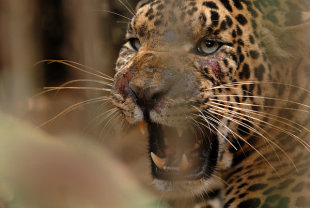Another brazen attack. Another fearsome mauling. Another leopard branded a man-eater pays for its crimes against humanity.
You've read the news. Now, will you teach your kids to kill leopards on sight? Or will you join cause with the (seemingly hare-brained) minority and cry yourself hoarse to protect leopards from humans?
Decide. We're out of time.
I'm a wildlife enthusiast. I'm also a parent. And, like you, I have a ravenous appetite for bizarre news, especially horrible things that happen to other people. But I'm batting for leopards here. And before you hurl something at me, let me explain my stand.
Leopards aren't exactly wild animals. A childhood conditioned by Amar Chitra Katha and Chandamama has most of us believe that leopards are confined to forests. They are, in fact, the most cosmopolitan of large felids. Panthers, as they are also known in India, are very much at home in the jungle where prey is available in plenty but, being hardy opportunists, they will expand their menu choices to exploit easy pickings in goats, dogs and pigs. Not surprisingly, they are often found very close to human habitation. In January, I chanced upon a full-grown leopard that had been run over by a truck just a few kilometers from Bangalore's Bannerghatta Road.
Just as humans prefer to live near malls and food courts, leopards tend to linger where food is plentiful. And cheap, which in a leopard's definition would mean "acquired with minimum energy and effort". In India, human settlements have increasingly encroached upon forest habitats, leading to their fragmentation. The leopard's prey species, such as deer and wild boar, frequently stray into crop fields. The cats, which follow them, turn their attention on livestock, which falls in the aforesaid "cheap" category. Inevitably, they come into close contact with humans, far closer than is healthy for either man or beast.
Man-eating behavior in leopards is an extremely contentious subject. Usually, people aggrieved by the loss of livestock find it convenient to escape the strictures of wildlife protection laws by tacking the blame on leopards. Man-eating cases sometimes aid police in "solving" cases related to missing persons including children. Claiming compensation for livestock killed by wild animals is also a thriving racket in some parts of India. This is not to say that man-eating does not occur. There is truth in some claims. In many cases, the offending leopards were found to be incapacitated by injury or blindness.
Jim Corbett, British India's most celebrated hunter of man-eaters, offered an interesting explanation for why leopards pick on humans. In the prologue to The Man-Eating Leopard of Rudraprayag, Corbett wrote that in the early 1900s, inhabitants of the Himalayan foothills had lost children and family to an epidemic. Since cremating their dead was an enormous expense for impoverished villagers, they performed perfunctory rituals and dumped the bodies in gorges and ravines. Corbett surmised that leopards must have become habituated to the easy availability of food and developed a taste for human flesh. The opportunistic cats lingered near human settlements. When maimed by a hunter's bullet, they knew where to find lunch.
Hunting, we are led to believe, is not as rampant as it used to be back then (although caches of leopard pelts continue to be seized). There's another thing: Leopards are known to eat dogs, which they pick up from villages and towns. This explains why they prowl the fringes of our cities. Tunnels, culverts and abandoned quarries provide ample hideouts for these rough-living predators, and stray dogs make for easy meat. Leopards frequently wander into Mumbai's suburbs from the Sanjay Gandhi National Park in Borivali, an impossible island of wilderness in one of the world's most populous cities.
The increasing conversion of forest to agricultural land mounts pressure on leopards' needs for food and territory. In the last few years we have read of human-leopard conflict in the tea gardens of northeast India, as well as in the Nilgiris and the Anamalais in southern India. The media relishes this stuff. It gets their blood up. To hacks weary of editing crime stories, any leopard that attacks a human, even in self-defense, becomes a man-eater.
When a crowd gathers around an intruding leopard it won't leave without witnessing, or preempting action. It will taunt and torment the cornered beast until it attacks in desperate self-defense. Most photographs and videos we see are of "man-eaters" deliberately provoked into attacking people. Media photographers will very often encourage the mob for a "dramatic" picture.
Wildlife photographer and conservationistKalyan Varma, whose laudable work in conservation fetched him the Sanctuary Wildlife Photographer of the Year Award in 2005, produced a telling photo-essay about a leopard captured in a trap set by forest officials in Valparai in the Anamalais, Tamil Nadu. Organizations such as Nature Conservation Foundation have been working with the government to educate the public about managing conflicts with leopards.
The Siliguri incident is the latest in a series of overenthusiastic and sensational media exposés on man-eaters. Similar incidents have been reported from Mysore, including two from the Infosys campus there, and another from the city's Chamundi Hills, in which a leopard was bludgeoned to death by police and bystanders. In all these cases, crowds provoked the leopards into attacking them.
In April the Ministry of Environment and Forests under its erstwhile chief, Jairam Ramesh, issued an official charter for managing human-leopard conflicts. The initiative, spearheaded by a number of wildlife activists including Varma and Vidya Athreya of Project Waghoba, offers guidelines for managing crowds, minimizing trauma, transporting and translocating captured animals, and helping rural people protect livestock from leopards. There's also a chapter on dealing with man-eaters. The exhaustive document, equally sensitive to both human and wildlife viewpoints, is arguably one of the most progressive directives issued by the Ministry in recent years. That said, none of its guidelines were applied during the Siliguri incident.
That's because leopards will be leopards. It's up to us to change our spots.
Photographs: Kalyan Varma (Used with permission)
Download the Guidelines for Human-Leopard Conflict Management from the website of the Ministry of Environment and Forests





